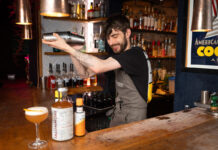Versatility and local ingredients put spirit back on the cocktail menu

GROWING consumer interest in the quality and provenance of food and drink seems to have contributed to a resurgence in gin sales.
Drinks companies told SLTN that a general shift towards locally-sourced and produced ingredients is encouraging consumers to take a more considered approach to their spirits purchases.
“The provenance and quality of liquids is being appreciated more than ever,” said Ervin Trykwoski, brand ambassador for Caorunn gin.
“The vast range and the differences between one gin to the next is gin’s biggest strength.
“There is growing interest from consumers around the heritage and provenance of what they are eating and drinking. Consumers are becoming inquisitive and always on the search for something new.
“Hype has been replaced with quality and authenticity.”
“There is a definite consumer trend to be interested in the provenance of ingredients,” said a spokeswoman for Wemyss Malts, the firm behind Darnley’s View gin. “I’m not sure whether this has yet reached the provenance of actual botanicals used in the London Dry style gins, however, there is at least a growing awareness of which gins contain what botanicals and an appreciation of the provenance of the gin brands.”
Quoting figures from CGA, Pernod Ricard said the volume of gin sold in the UK on-trade last year was up 2.7%, while sales rose 12.7% in value terms.
Ian Peart, on-trade channel director for spirits at the Beefeater gin owner, credited bartenders’ enthusiasm for the spirit for contributing to the buoyant sales picture.
“The trade is increasingly supporting the gin category with bartenders and brand ambassadors out there singing the praises and extolling the virtues of gin,” he said.
“They are an extremely powerful force to have on side and we believe the growing popularity is in no small part due to the passionate support of gin that is out there in the trade.”
Peart also agreed that gin is well-positioned to capitalise on the growing consumer demand for information on the provenance of ingredients.
“Gins by their nature use botanicals from all over the world, so provenance is already an important aspect,” he said.
Consumer interest in gin and its botanicals is not the only aspect of the category that’s seen change.
The way the spirit is consumed has also evolved in recent years, according to James Hayman, director of Hayman Distillers.
“The classic gin and tonic is certainly very popular, largely due to an increased quality of both serve and mixers available,” he said.
“However, gin cocktails are where it’s at right now.
“This has been helped by people in the drinks trade travelling round the world and promoting both cocktails and the importance of using the best quality ingredients available to ensure the best quality.
“It’s something which has already happened with food.”
Hayman said offering a variety of gin serves could help operators capitalise on the category’s popularity during the busy summer months, advising licensees to offer a range of simple-to-make gin cocktails.
Trykwoski, who works at Glasgow bar The Finnieston in addition to his role as brand ambassador for Caorunn, was also quick to extol the virtues of simple gin serves.
“Offering simple long drinks with a twist, things like the pink G&T or a gin and tonic but with half apple juice, half tonic, great ingredients and attention to detail help enormously,” said Ervin.
“Simple takes on classic cocktails will never go wrong.
“Also, a good fresh fruit garnish goes a long way. Whatever the context, good drinks made well will be perfect for any season.”
Hayman suggested that flavour and versatility have played a key role in the popularity of the spirit – and in winning consumers away from other spirits categories.
He said consumers now appreciate gin’s “complexity and balance and the flavour and depth this adds to cocktails”.
Beyond traditional gin cocktails, further innovation in the category could open up a new range of modern gin serves, according to Bob Fowkes, director of Brockmans gin.
“The gin category offers immense opportunities for further innovation – particularly as you move beyond the simple London Dry taste formulas,” he said. “To some people this is moving beyond the accepted scope of gin but it is important to remember that gin started as a medicine in Holland and has developed substantially in that time.
“Even the London Dry gin style is a relatively new innovation in the long history of the category.
“The potential for new recipes and interpretations is substantial and we hope the creativity will continue.”
Ensuring a range of gins is stocked was considered important by all producers and distributors contacted by SLTN.
Hayman said by stocking a variety, bartenders can create a range of drinks using the appropriate gin for each serve.
However, Peart warned that a good stock of gin is not enough to guarantee strong sales.
“Premium spirits are outperforming standard spirits, so there is a significant opportunity for licensees to drive profit margins by stocking a range of premium gins,” he added.
“However, it is not enough just to have the range in place; it is also important for the on-trade to know their audience and make sure bar staff know their gin to really capitalise on this premium opportunity.”
Image – Gin producers and distributors said consumers appreciate the spirit’s complexity and balance.
The Heather Martini
50ml Caorunn gin
20ml Drambuie
5ml Talisker (or any other smoky malt)
6oz Martini/cocktail glass
Method: shake all ingredients with ice and fine-strain into a chilled glass.
Brockmans Bramble
40ml Brockmans gin
20ml freshly squeezed lemon juice
15ml sugar syrup
15ml Creme de Mure
Method: shake first three ingredients with ice, strain into chilled glass, pour over the liqueur and garnish with blackberries.



















